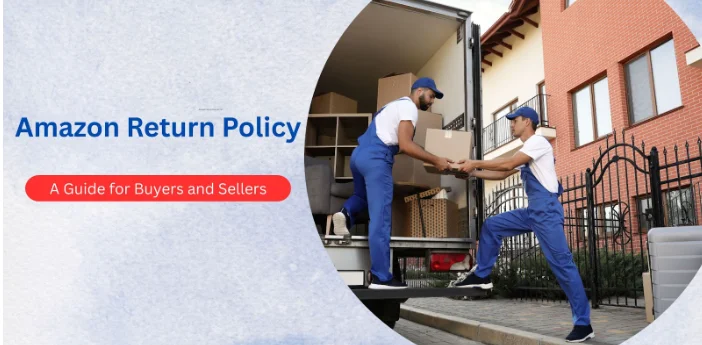Amazon’s Return Policy in 2025: What Buyers and Sellers Need to Know

Amazon’s return policy has long been considered one of the most customer-friendly in the eCommerce world. But over the years, especially heading into 2025, the return landscape has evolved, with new rules, added fees, and a stronger focus on reducing operational waste.
Whether you’re a regular buyer or a third-party seller, it’s important to understand what’s changed, what stays consistent, and how these policies impact your experience and bottom line.
In this article, we break down Amazon’s 2025 return policy updates, including what you need to know about FBA returns, return processing fees, returnless refunds, and even the growing business of Amazon return pallets.
Understanding Amazon’s Standard Return Policy
Amazon’s standard return policy allows customers to return most items within 30 days of receipt. That standard return window continues to apply to items shipped and sold by Amazon, as well as by many third-party sellers who use Fulfilled by Amazon (FBA). However, return windows are often extended during key seasonal periods.
For example, items purchased between November 1 and December 31 typically qualify for an extended return period through January 31, a holiday-friendly grace period Amazon has retained for years.
In some product categories, such as baby items or registry purchases, the return window may be extended up to 90 days.
On the flip side, certain product types like perishable goods, customized orders, downloadable software, or intimate health products are excluded entirely and marked as non-returnable. As a shopper, your best bet is to always check the return eligibility listed next to the item before purchasing.
If you’re a seller, especially on the FBA side, being proactive with detailed listings can help reduce confusion and, ultimately, avoid unnecessary returns.
Navigating FBA Returns: What Sellers Need to Know
For sellers utilizing FBA, Amazon handles the entire return process, from customer service to restocking. When a customer initiates a return, Amazon assesses the item’s condition upon receipt and categorizes it as either:
- Sellable: The item is in new condition and can be returned to inventory.
- Unsellable: The item is damaged, defective, or otherwise not in a condition to be resold.
Sellers are notified of returns and can view detailed reports in their Seller Central account. If an item is deemed unsellable, sellers can request its return or opt for disposal. It’s crucial for sellers to monitor these reports to identify patterns and address potential issues proactively.
Implementing Returnless Refunds: Pros and Cons
Amazon offers sellers the option to issue returnless refunds, where customers receive a refund without returning the item. This approach is beneficial for low-cost items or situations where return shipping costs outweigh the item’s value.
Advantages:
- Reduces shipping and processing costs.
- Enhances customer satisfaction by simplifying the return process.
- Minimizes environmental impact by reducing transportation.
Disadvantages:
- Potential for abuse if not monitored properly.
- Loss of inventory without the possibility of resale.
Sellers can configure returnless refund settings in Seller Central, specifying criteria such as product category, price range, and return reasons.
Exploring Amazon Return Pallets: Opportunities for Resellers
Returned items that cannot be resold as new are often bundled into pallets and sold through liquidation platforms. These Amazon return pallets present opportunities for resellers to purchase merchandise at discounted rates.
Key Platforms:
- B-Stock: Offers liquidation auctions for returned, overstock, and refurbished items from Amazon and other major retailers.
- Direct Liquidation: Provides access to Amazon return pallets, including electronics, home goods, and more.
- Liquidation.com: Features a wide range of product categories and allows buyers to bid on pallets.
While purchasing return pallets can be profitable, it’s essential to conduct thorough research, understand the risks, and have a strategy for testing, refurbishing, or reselling items.
Strategies for Minimizing Returns and Associated Costs
To reduce return rates and avoid additional fees, sellers should consider the following strategies:
- Accurate Product Listings: Ensure product descriptions, images, and specifications are detailed and accurate to set proper customer expectations.
- Quality Control: Regularly inspect inventory to identify and address defects or issues before items are shipped.
- Customer Feedback: Monitor reviews and feedback to identify common return reasons and make necessary adjustments.
- Clear Return Policies: Communicate return policies transparently to avoid misunderstandings.
By proactively managing these aspects, sellers can enhance customer satisfaction and reduce the likelihood of returns.
Understanding Reimbursement Policies for FBA Sellers
In cases where Amazon is responsible for a return issue, such as a lost item or damage during fulfillment, sellers may be eligible for reimbursement. However, these reimbursements are not always automatic. Sellers should regularly audit their accounts and file claims when necessary to recover potential losses.
Tools like Getida can assist sellers in identifying and claiming eligible reimbursements, ensuring they don’t miss out on owed funds.
Final Thoughts
As Amazon continues to refine its return policies, sellers must stay informed and adapt to changes to maintain profitability and customer satisfaction. By understanding the nuances of FBA returns, implementing strategies to minimize returns, and exploring opportunities within the return ecosystem, sellers can navigate the evolving landscape effectively.
Staying proactive, leveraging available tools, and maintaining open communication with customers are key components to success in managing Amazon returns in 2025 and beyond.
Author Bio:
Prateek S. is an experienced SEO Analyst and writer specializing in eCommerce with over two years of expertise. Currently at SellerApp, he excels in crafting clear and insightful content that breaks down complex eCommerce concepts, helping businesses optimize their online presence. His work reflects a deep understanding of the digital marketplace, providing practical guidance to those navigating this ever changing industry.

Step-by-Step Guide to Filing Reconsideration Requests in UAE Tax Assessments

Smart, Simple, Seamless: The Rise of NFC Business Cards

Top Features of Dynamics 365 Customer Engagement You Should Be Using

Accelerating drug discovery through the DEL-ML-CS approach

AI in Marketing Is No Longer a Buzzword — It’s the Strategy

The Future of eCommerce: AI, Automation, and Scalable Software Solutions

The Evolution of E-Commerce: How Digital Innovation is Reshaping Online Shopping

Amazon’s Return Policy in 2025: What Buyers and Sellers Need to Know








